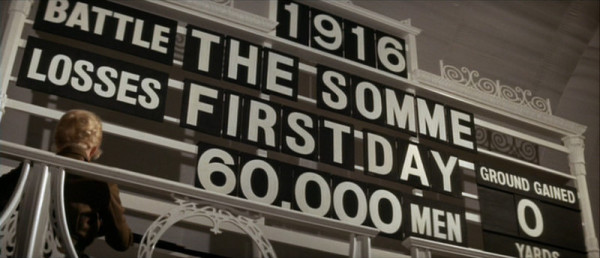
East Finchley’s Phoenix Cinema quite rightly chose to mark the centenary of WWI, the passing of Richard Attenborough and the open house weekend to showcase its beautiful 1910 building (at its opening the cinema was known as The Picturedrome) and a screening of the 1969 tour de force, Oh! What a Lovely War, a film which celebrated its 45th anniversary of release last April.
Director and actor Richard Attenborough, funnily enough most likely remembered by younger audiences as the man who tried to bring dinosaurs back to life in 1993’s Jurassic Park, was responsible for directing the film of the stage play known for being starkly but wryly honest about the origins of WW1 and its effect on our nation’s psyche.
The film contained many of that time’s biggest stars; Maggie Smith, Vanessa Redgrave, Dirk Bogarde, John Gielgud, Laurence Olivier, John Mills (plus other members of the acting dynasties of Mills and Redgrave) and much of the action was set on the seafront of Brighton; the gateway to the extravaganza of World War I, where carousels turn into forests scattered with the Belgian soldierly dead, where tiny seaside trains don’t just lead you along the promenade but to your almost certain death on the Somme as you and your family, who are being left behind while you go off to fight, sing ‘Goodbye-ee, goodbye-ee, Wipe the tear, baby dear, from your eye-ee..’
Oh! What a Lovely War quite rightly claims its place amongst the barrage of war films we have been subjected to over the years but with a difference; there is no focus on the fighting itself, no claims of heroism or bravado, just many reflections on the very real human story. The fear, the hopelessness and the realisation of many young men in the trench and on the battleground that there isn’t an upside to going to war. The very realisations that should prevent any war, the realisations that meant people referred to WW1 as The Great War because they did not believe that such a loss of life and heart could ever happen again on such a scale.
The film does not deny its stage foundations and, in that manner, finds a way to reach out to those who would not normally watch a war film. The film builds well on the drama of the beginnings of the war; the spat between European aristocracy, the joint assurances that it wouldn’t last very long, the refusals to accept offers of ceasing bloodshed, the overblowing of events into a war that was incredibly unlovely. Oh! What a Lovely War ridicules the entitlement of the officer class in a way that will be very familiar to those with an interest in Monty Python and Elton/Curtis’ Blackadder, which collectively took many pot shots at the institution of the army with The Meaning of Life and TV series Blackadder Goes Forth. Particularly poignant in Oh! What a Lovely War are the scenes showing Haig and his colleagues waltzing around the ballroom while boards display the latest numbers of allied deaths in each battle. Discussions of job promotions and lunches at Number 10 seemingly weighing more heavily on their minds than the heavy loss of life that their decisions were responsible for.
Not to take anything away from the dialogue, but the full impact of the film can be found in the imagery: the starkness of blending the innocence, bright lights and ice-cream colours of the seaside town with the blood and dashed hopes of the field hospital, the popular songs of the time bringing an added realism to a setting that should really be ridiculous but just highlights the futility of war to the fullest extent possible. The end scene of the film is dominated by camera panning out on the sight of innumerable rows and rows of white crosses, a sense of calm and peace washing away the hurt and uncertainty of war. Until the next time.
People would have sat under the barrel-vaulted ceiling of the East Finchley Picturedrome cinema and watched footage of people on the front line in the same situation that their own family members could have been in, 1914 being a budding time in the life of film and the cinema. Oh! What a Lovely War did recreate the scenarios in some of these short films, such as the meeting of ‘Tommy” and “Jerry” in the middle of no man’s land one Christmas, so once again manages to be entirely relevant to the events of that time, a time when we were more keenly aware of the effects of war than ever before. Showing Oh! What a Lovely War is certainly a fitting tribute to Lord Richard Attenborough: his first stint in the directorial chair produced a film that anyone could be proud of making..












{ 0 comments… add one now }